Research Trends of Human–Computer Interaction Studies in Construction Hazard Recognition: A Bibliometric Review
Abstract
:1. Introduction
2. Research Process
2.1. Paper Retrieval
2.2. Bibliometric Analysis Method
3. Basic Information Analysis
3.1. Number of Annual Publications
3.2. Composition of Literature Types
3.3. Publication Country/Region
4. Keyword Co-Occurrence Network
4.1. Terms Related to Construction Safety and Hazard Recognition
4.2. Terms Related to Human-Computer Interaction
4.3. Terms Related to Machine Learning and Specific Algorithms
5. Cluster Analysis
5.1. Cluster 1: Computer Vision
5.2. Cluster 2: Ergonomics
5.3. Cluster 3: Computer Simulation
5.4. Cluster 4: Virtual Reality
6. Keyword Timeline Analysis
7. Framework Development, Future Directions and Discussion
7.1. Framework Development
7.2. Future Directions
7.2.1. Improve Algorithms to Process Multimodal Data in Hazard Recognition Experiments
7.2.2. Develop Intuitive Devices for Hazard Recognition
7.2.3. Establish Integrated Safety Management Platforms
8. Conclusions
Author Contributions
Funding
Institutional Review Board Statement
Informed Consent Statement
Data Availability Statement
Acknowledgments
Conflicts of Interest
References
- Encyclopedia Britannica. Available online: https://www.britannica.com/topic/human-machine-interaction (accessed on 14 July 2021).
- Kim, D.; Goyal, A.; Newell, A.; Lee, S.; Deng, J.; Kamat, V.R. Semantic relation detection between construction entities to support safe human-Robot collaboration in construction. In Proceedings of the Computing in Civil Engineering 2019: Data, Sensing, and Analytics, Atlanta, GA, USA, 17–19 June 2019; pp. 265–272. [Google Scholar]
- Zhou, Z.; Goh, Y.M.; Li, Q. Overview and analysis of safety management studies in the construction industry. Saf. Sci. 2015, 72, 337–350. [Google Scholar] [CrossRef]
- Albert, A.; Hallowell, M.R.; Skaggs, M.; Kleiner, B. Empirical measurement and improvement of hazard recognition skill. Saf. Sci. 2017, 93, 1–8. [Google Scholar] [CrossRef]
- Ladewski, B.J.; Al-Bayati, A.J. Quality and safety management practices: The theory of quality management approach. J. Saf. Res. 2019, 69, 193–200. [Google Scholar] [CrossRef]
- Aniekwu, N. Accidents and Safety violations in the Nigerian construction industry. J. Sci. Technol. 2007, 27, 81–89. [Google Scholar] [CrossRef]
- Schulte, A.; Donath, D.; Lange, D.S.; Gutzwiller, R.S. A Heterarchical Urgency-Based Design Pattern for Human Automation Interaction. In Proceedings of the 15th International Conference on Engineering Psychology and Cognitive Ergonomics, Las Vegas, NV, USA, 15–20 July 2018. [Google Scholar]
- Ganbat, T.; Chong, H.P.; Liao, P.-C.; Wu, Y.D.; Zhao, X.B. A Bibliometric Review on Risk Management and Building Information Modeling for International Construction. Adv. Civ. Eng. 2018, 2018, 8351679. [Google Scholar] [CrossRef] [Green Version]
- Marvel, J.A.; Falco, J.; Marstio, I. Characterizing task-based human-robot collaboration safety in manufacturing. IEEE Trans. Syst. Man Cybern. Syst. 2014, 45, 260–275. [Google Scholar] [CrossRef]
- Blashfield, R.K.; Kaufman, L.; Rousseeuw, P.J. Finding groups in data—An introduction to cluster-analysis. J. Classif. 1991, 8, 277–279. [Google Scholar]
- Chen, C.; Chen, Y.; Hou, J.; Liang, Y. CiteSpace II: Detecting and Visualizing Emerging Trends and Transient Patterns in Scientific Literature. J. China Soc. Sci. Tech. Inf. 2009, 28, 401–421. [Google Scholar] [CrossRef] [Green Version]
- Borys, D. The role of safe work method statements in the Australian construction industry. Saf. Sci. 2012, 50, 210–220. [Google Scholar] [CrossRef] [Green Version]
- Zhang, M.; Cao, T.; Zhao, X. Applying sensor-based technology to improve construction safety management. Sensors 2017, 17, 1841. [Google Scholar] [CrossRef] [Green Version]
- Farahani, S.; Tahershamsi, A.; Behnam, B. Earthquake and post-earthquake vulnerability assessment of urban gas pipelines network. Nat. Hazards 2020, 101, 327–347. [Google Scholar] [CrossRef]
- Joyner, M.D.; Sasani, M. Building performance for earthquake resilience. Eng. Struct. 2020, 210, 110371. [Google Scholar] [CrossRef]
- Fu, G.; Xie, X.C.; Jia, Q.S.; Tong, W.Q.; Ge, Y. Accidents analysis and prevention of coal and gas outburst: Understanding human errors in accidents. Process. Saf. Environ. Prot. 2020, 134, 1–23. [Google Scholar] [CrossRef]
- Yeo, C.J.; Yu, J.H.; Kang, Y. Quantifying the Effectiveness of IoT Technologies for Accident Prevention. J. Manag. Eng. 2020, 36, 04020054. [Google Scholar] [CrossRef]
- Vähä, P.; Känsälä, K.; Heikkilä, R. Use of 3-D product models in construction process automation. Autom. Constr. 1997, 6, 69–76. [Google Scholar] [CrossRef]
- Saidi, K.S.; Bock, T.; Georgoulas, C. Robotics in construction. In Springer Handbook of Robotics; Springer: Cham, Switzerland, 2016; pp. 1493–1520. [Google Scholar]
- Guo, H.; Yu, Y.; Skitmore, M. Visualization technology-based construction safety management: A review. Autom. Constr. 2017, 73, 135–144. [Google Scholar] [CrossRef]
- Ikeda, Y. The automated building construction system for high-rise steel structure building. In Proceedings of the Council on Tall Buildings and Urban Habitat (CTBUH) 2004, Seoul, Korea, 10–13 October 2004. [Google Scholar]
- Yamazaki, Y.; Maeda, J. The SMART system: An integrated application of automation and information technology in production process. Comput. Ind. 1998, 35, 87–99. [Google Scholar] [CrossRef]
- Wakisaka, T.; Furuya, N.; Inoue, Y. Automated construction system for high-rise reinforced concrete buildings. Autom. Constr. 2000, 9, 229–250. [Google Scholar] [CrossRef]
- Bock, T. Construction robotics. Auton. Robot. 2007, 22, 201–209. [Google Scholar] [CrossRef]
- Schmidhuber, J. Deep learning in neural networks: An overview. Neural Netw. 2015, 61, 85–117. [Google Scholar] [CrossRef] [Green Version]
- Lee, S.; Moon, J.I. Introduction of human-robot cooperation technology at construction sites. In Proceedings of the 31st International Symposium on Automation and Robotics in Construction and Mining (ISARC 2014), Sydney, Australia, 9–11 July 2014; Volume 31, pp. 1–6. [Google Scholar]
- Sobotka, A.; Pacewicz, K. Mechanisation and automation technologies development in work at construction sites. IOP Conf. Ser. Mater. Sci. Eng. 2017, 251, 012046. [Google Scholar] [CrossRef] [Green Version]
- Nurmikko, A.V.; Donoghue, J.P.; Hochberg, L.R.; Patterson, W.R.; Song, Y.K.; Bull, C.W.; Shang, D.A.; Zhang, H.X.; Zhu, L.; Sun, J.D. Adversarial cross-modal retrieval based on dictionary learning. Neurocomputing 2019, 355, 93–104. [Google Scholar]
- Ma, C.; Luo, G.N.; Wang, K.Q. Concatenated and Connected Random Forests with Multiscale Patch Driven Active Contour Model for Automated Brain Tumor Segmentation of MR Images. IEEE Trans. Med. Imaging 2018, 37, 1943–1954. [Google Scholar] [CrossRef]
- Lantzanakis, G.; Mitraka, Z.; Chrysoulakis, N. X-SVM: An Extension of C-SVM Algorithm for Classification of High-Resolution Satellite Imagery. IEEE Trans. Geosci. Remote. Sens. 2021, 59, 3805–3815. [Google Scholar] [CrossRef]
- Zhang, H.; Wang, T.; Dai, G. Semi-supervised cross-modal common representation learning with vector-valued manifold regularization. Pattern Recognit. Lett. 2020, 130, 335–344. [Google Scholar] [CrossRef]
- Waltman, L.; Eck, N.J.; Noyons, E.C.M. A unified approach to mapping and clustering of bibliometric networks. J. Inf. 2010, 4, 629–635. [Google Scholar] [CrossRef] [Green Version]
- Guo, B.H.W.; Zou, Y.; Fang, Y.; Goh, Y.M.; Zou, P.X.W. Computer vision technologies for safety science and management in construction: A critical review and future research directions. Saf. Sci. 2021, 135, 105130. [Google Scholar] [CrossRef]
- Luo, H.; Wang, M.; Wong, P.K.Y.; Tang, J.; Cheng, J.C.P. Construction machine pose prediction considering historical motions and activity attributes using gated recurrent unit (GRU). Autom. Constr. 2021, 121, 103444. [Google Scholar] [CrossRef]
- Hossain, M.M.; Prybutok, V.R. Towards developing a business performance management model using causal latent semantic analysis. Int. J. Bus. Perform. Manag. 2016, 17, 161–183. [Google Scholar] [CrossRef]
- Wang, H.T.; Song, L.H.; Xiang, T.T.; Liu, L.J. New Development Direction of Artificial Intelligence—Human Cyber Physical Ternary Fusion Intelligence. Chin. Comput. Sci. 2020, 47, 1–5+22. [Google Scholar]
- Yan, X. Development of ergonomic posture recognition technique based on 2D ordinary camera for construction hazard prevention through view-invariant features in 2D skeleton motion. Adv. Eng. Inform. 2017, 34, 152–163. [Google Scholar] [CrossRef]
- Kowalski-Trakofler, K.M.; Barrett, E.A. The concept of degraded images applied to hazard recognition training in mining for reduction of lost-time injuries. J. Saf. Res. 2003, 34, 515–525. [Google Scholar] [CrossRef] [PubMed]
- Zhang, H.; Yan, X.; Li, H. Ergonomic posture recognition using 3D view-invariant features from single ordinary camera. Autom. Constr. 2018, 94, 1–10. [Google Scholar] [CrossRef]
- Hasanzadeh, S.; Esmaeili, B.; Michael, D. Impact of Construction Workers’ Hazard Identification Skills on Their Visual Attention. J. Constr. Eng. Manag. 2017, 143, 04017070. [Google Scholar] [CrossRef] [Green Version]
- Akanmu, A.A.; Olayiwola, J.; Ogunseiju, O.; McFeeters, D. Cyber-physical postural training system for construction workers. Autom. Constr. 2020, 117, 103272. [Google Scholar] [CrossRef]
- Inyang, N.; Al-Hussein, M. Ergonomic hazard quantification and rating of residential construction tasks C3. In Proceedings of the Annual Conference Canadian Society for Civil Engineering, Ottawa, ON, Canada, 14–17 June 2011. [Google Scholar]
- Kim, K.; Chen, J.; Cho, Y.K. Evaluation of Machine Learning Algorithms for Worker’s Motion Recognition Using Motion Sensors. In Proceedings of the Computing in Civil Engineering 2019: Data, Sensing, and Analytics, Atlanta, GA, USA, 17–19 June 2019. [Google Scholar]
- Asadzadeh, A.; Arashpour, M.; Li, H.; Ngo, T.; Bab-Hadiashar, A.; Rashidi, A. Sensor- based safety management. Autom. Constr. 2020, 113, 103128. [Google Scholar] [CrossRef]
- Hu, Z.; Zhang, J.; Zhang, X. Construction collision detection for site entities based on 4-D space time model. J. Tsinghua Univ. Sci. Technol. 2010, 50, 820–825. [Google Scholar]
- Zhang, S.; Teizer, J.; Lee, J.K. Building information modeling (BIM) and safety: Automatic safety checking of construction models and schedules. Autom. Constr. 2013, 29, 183–195. [Google Scholar] [CrossRef]
- Benjaoran, V.; Bhokha, S. An integrated safety management with construction management using 4D CAD model. Saf. Sci. 2010, 48, 395–403. [Google Scholar] [CrossRef]
- Huang, D.; Wang, X.; Li, J.; Tang, W. Virtual Reality for Training and Fitness Assessments for Construction Safety. In Proceedings of the 2020 International Conference on Cyberworlds (CW), Caen, France, 29 September–1 October 2020. [Google Scholar]
- Skibniewski, M.J.; Jang, W.S. Simulation of accuracy performance for wireless sensor-based construction asset tracking. Comput.-Aided Civ. Infrastruct. Eng. 2009, 24, 335–345. [Google Scholar] [CrossRef]
- Newman, M.E.J. Modularity and community structure in networks. Proc. Natl. Acad. Sci. USA 2006, 103, 8577–8582. [Google Scholar] [CrossRef] [PubMed] [Green Version]
- Moon, H.; Dawood, N.; Kang, L. Development of workspace conflict visualization system using 4D object of work schedule. Adv. Eng. Inform. 2014, 28, 50–65. [Google Scholar] [CrossRef]
- Zhang, J.P.; Hu, Z.Z. BIM-and 4D-based integrated solution of analysis and management for conflicts and structural safety problems during construction: 1. Principles and methodologies. Autom. Constr. 2011, 20, 155–166. [Google Scholar] [CrossRef]
- Pradhananga, N.; Teizer, J. Automatic spatio-temporal analysis of construction site equipment operations using GPS data. Autom. Constr. 2013, 29, 107–122. [Google Scholar] [CrossRef]
- Montaser, A.; Moselhi, O. RFID indoor location identification for construction projects. Autom. Constr. 2014, 39, 167–179. [Google Scholar] [CrossRef]
- Yang, J.J.; Ye, G.; Xiang, Q.T.; Kim, M.; Liu, Q.J.; Yue, H.Z. Insights into the mechanism of construction workers’ unsafe behaviors from an individual perspective. Saf. Sci. 2021, 133, 105004. [Google Scholar] [CrossRef]
- Li, H.; Chan, G.; Wong, J.K.W. Real-time locating systems applications in construction. Autom. Constr. 2016, 63, 37–47. [Google Scholar] [CrossRef] [Green Version]
- Maalek, R.; Sadeghpour, F. Accuracy assessment of Ultra-Wide Band technology in tracking static resources in indoor construction scenarios. Autom. Constr. 2013, 30, 170–183. [Google Scholar] [CrossRef]
- Wu, F.; Lu, X.; Song, J.; Yan, S.; Zhang, Z.M.; Rui, Y.; Zhuang, Y. Learning of Multimodal Representations with Random Walks on the Click Graph. IEEE Trans. Image Process. 2016, 25, 630–642. [Google Scholar] [CrossRef] [PubMed]
- Yao, T.; Pan, Y.W.; Li, Y.H.; Mei, T. Incorporating Copying Mechanism in Image Captioning for Learning Novel Objects. In Proceedings of the 30th IEEE Conference on Computer Vision and Pattern Recognition, Honolulu, HI, USA, 22–25 July 2017; pp. 5263–5271. [Google Scholar]
- Xia, Y.J.; Zhang, L.M.; Liu, Z.G.; Nie, L.Q.; Li, X.L. Weakly Supervised Multimodal Kernel for Categorizing Aerial Photographs. IEEE Trans. Image Process. 2017, 26, 3748–3758. [Google Scholar] [CrossRef] [PubMed]
- Li, H.B.; Sun, J.; Xu, Z.B.; Chen, L.M. Multimodal 2D + 3D Facial Expression Recognition with Deep Fusion Convolutional Neural Network. IEEE Trans. Multimed. 2017, 19, 2816–2831. [Google Scholar] [CrossRef]
- Meng, X.R.; Xu, X.Z.; Zhao, G.M. True three-dimensional coal mine personnel positioning system based on 3D visualization and Zigbee technology. J. China Coal Soc. 2014, 39, 603–608. [Google Scholar]
- Jeelani, I.; Albert, A.; Han, K.; Azevedo, R. Are Visual Search Patterns Predictive of Hazard Recognition Performance? Empirical Investigation Using Eye-Tracking Technology. J. Constr. Eng. Manag. 2018, 145, 111–113. [Google Scholar] [CrossRef]
- Sharafi, Z.; Soh, Z.; Guéhéneuc, Y. A systematic literature review on the usage of eye-tracking in software engineering. Inf. Softw. Technol. 2015, 67, 79–107. [Google Scholar] [CrossRef]
- Hasanzadeh, S.; Esmaeili, B.; Dodd, M.D. Examining the Relationship between Construction Workers’ Visual Attention and Situation Awareness under Fall and Tripping Hazard Conditions: Using Mobile Eye Tracking. J. Constr. Eng. Manag. 2018, 144, 04018060. [Google Scholar] [CrossRef] [Green Version]
- Dolezalova, J.; Popelka, S. Evaluation of the User Strategy on 2D and 3D City Maps Based on Novel Scan-Path Comparison Method and Graph Visualization. Int. Arch. Photogramm. Remote Sens. Spat. Inf. 2016, XLI-B2, 637–640. [Google Scholar] [CrossRef] [Green Version]
- Xu, Q.; Chong, H.-Y.; Liao, P.-C. Exploring eye-tracking searching strategies for construction hazard recognition in a laboratory scene. Saf. Sci. 2019, 120, 824–832. [Google Scholar] [CrossRef]
- Xu, Q.; Chong, H.-Y.; Liao, P.-C. Collaborative information integration for construction safety monitoring. Autom. Constr. 2019, 102, 120–134. [Google Scholar] [CrossRef]
- Siddharth, B.; Alex, A.; Matthew, R. Construction Hazard Recognition: Themes in Scientific Research. In Proceedings of the Construction Research Congress 2020: Safety, Workforce, and Education, Tempe, AZ, USA, 8–10 March 2020. [Google Scholar]
- Bhandari, S.; Hallowell, M.R.; Correll, J. Making construction safety training interesting: A field-based quasi-experiment to test the relationship between emotional arousal and situational interest among adult learners. Saf. Sci. 2019, 117, 58–70. [Google Scholar] [CrossRef]
- Lingard, H. Occupational health and safety in the construction industry. Constr. Manag. Econ. 2013, 31, 505–514. [Google Scholar] [CrossRef]
- Albert, A.; Hallowell, M.R.; Kleiner, B.M. Enhancing construction hazard recognition and communication with energy-based cognitive mnemonics and safety meeting maturity model: Multiple baseline study. J. Constr. Eng. Manag. 2013, 140, 04013042. [Google Scholar] [CrossRef]
- Haslam, R.A.; Hide, S.A.; Gibb, A.G.F.; Gyi, D.E.; Pavitt, T.; Atkinson, S.; Duff, A.R. Contributing factors in construction accidents. Appl. Ergon. 2005, 36, 401–415. [Google Scholar] [CrossRef] [Green Version]
- Tixier, A.J.; Hallowell, M.R.; Albert, A.; Boven, L.; Kleiner, B.M. Psychological antecedents of risk-taking behavior in construction. J. Constr. Eng. Manag. 2014, 140, 04014052. [Google Scholar] [CrossRef] [Green Version]
- Wang, D.; Chen, J.; Zhao, D.; Dai, F.; Zheng, C.; Wu, X. Monitoring workers’ attention and vigilance in construction activities through a wireless and wearable electroencephalography system. Autom. Constr. 2017, 82, 122–137. [Google Scholar] [CrossRef]
- Domdouzis, K.; Kumar, B.; Anumba, C. Radio-Frequency Identification (RFID) applications: A brief introduction. Adv. Eng. Inform. 2007, 21, 350–355. [Google Scholar] [CrossRef]
- Jiang, S.; Skibniewski, M.J.; Yuan, Y. Ultra-wide band applications in industry: A critical review. J. Civ. Eng. Manag. 2011, 17, 437–444. [Google Scholar] [CrossRef]
- Hasanzadeh, S.; Esmaeili, B.; Dodd, M. Measuring construction workers’ real-time situation awareness using mobile eye-tracking. In Proceedings of the Construction Research Congress, San Juan, Puerto Rico, 31 May–2 June 2016; pp. 2894–2904. [Google Scholar]
- Aryal, A.; Ghahramani, A.; Becerik-Gerber, B. Monitoring fatigue in construction workers using physiological measurements. Autom. Constr. 2017, 82, 154–165. [Google Scholar] [CrossRef]
- Brito, R.; Pradhananga, N.; Jianu, R.; Orabi, W. Eye-Tracking Technology for Construction Safety: A Feasibility Study. In Proceedings of the International Symposium on Automation and Robotics in Construction, Auburn, AL, USA, 18–21 July 2016; pp. 282–290. [Google Scholar]
- Chen, J.; Song, X.; Lin, Z. Revealing the “invisible gorilla” in construction: Estimating construction safety through mental workload assessment. Autom. Constr. 2016, 63, 173–183. [Google Scholar] [CrossRef]
- Wang, D.; Li, H.; Chen, J. Detecting and measuring construction workers’ vigilance through hybrid kinematic-EEG signals. Autom. Constr. 2019, 100, 11–23. [Google Scholar] [CrossRef]
- International Organization for Standardization. Robots and Robotic Devices-Safety Requirements for Industrial Robots—Part 2: Robots Systems and Integration; International Organization for Standardization: Geneva, Switzerland, 2011. [Google Scholar]
- Jamil, S.M.; Albert, A.; Alsharef, A.; Pandit, B.; Patil, Y. Hazard Recognition Patterns Demonstrated by Construction Workers. Int. J. Environ. Res. Public Health 2020, 17, 7788. [Google Scholar]
- Derlukiewicz, D.; Ptak, M.; Koziołek, S. Proactive failure prevention by human-machine interface in remote-controlled demolition robots. New Adv. Inf. Syst. Technol. 2016, 1, 711–720. [Google Scholar]
- Tanzini, M.; Tripicchio, P.; Ruffaldi, E. A novel human-machine interface for working machines operation. In Proceedings of the IEEE RO-MAN, Gyeongju, Korea, 26–29 August 2013; Volume 1, pp. 744–750. [Google Scholar]
- Patrinostro, S.; Tanzini, M.; Satler, M. A haptic-assisted guidance system for working machines based on virtual force fields. In Proceedings of the XXV International Conference on Information, Communication and Automation Technologies, Sarajevo, Bosnia and Herzegovina, 29–31 October 2015; Volume 1, pp. 1–6. [Google Scholar]
- Jacinto-Villegas, J.M.; Satler, M.; Filippeschi, A. A novel wearable haptic controller for teleoperating robotic platforms. IEEE Robot. Autom. Lett. 2017, 2, 2072–2079. [Google Scholar] [CrossRef]
- Moon, J.; Son, Y.; Park, S. Development of immersive augmented reality interface for construction robotic system. In Proceedings of the International Conference on Control, Automation and Systems, Seoul, Korea, 17–20 October 2007; Volume 1, pp. 1192–1197. [Google Scholar]
- Zhu, Z.; Ren, X.; Chen, Z. Integrated detection and tracking of workforce and equipment from construction jobsite videos. Autom. Constr. 2017, 81, 161–171. [Google Scholar] [CrossRef]
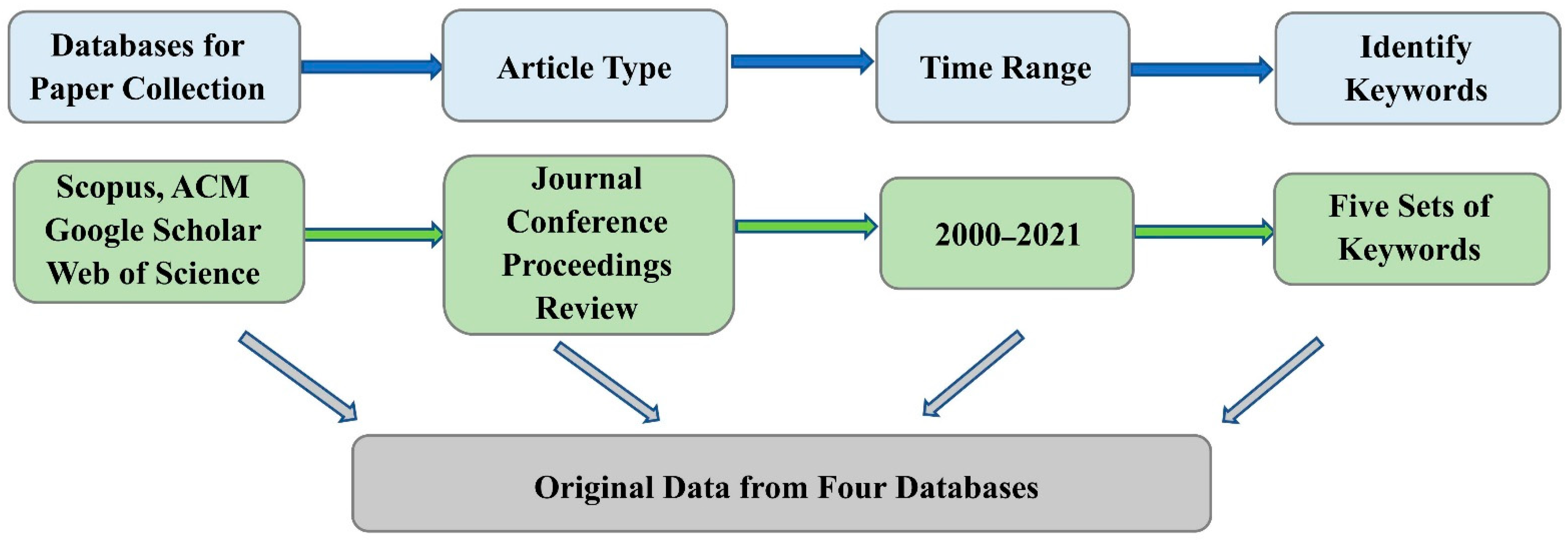

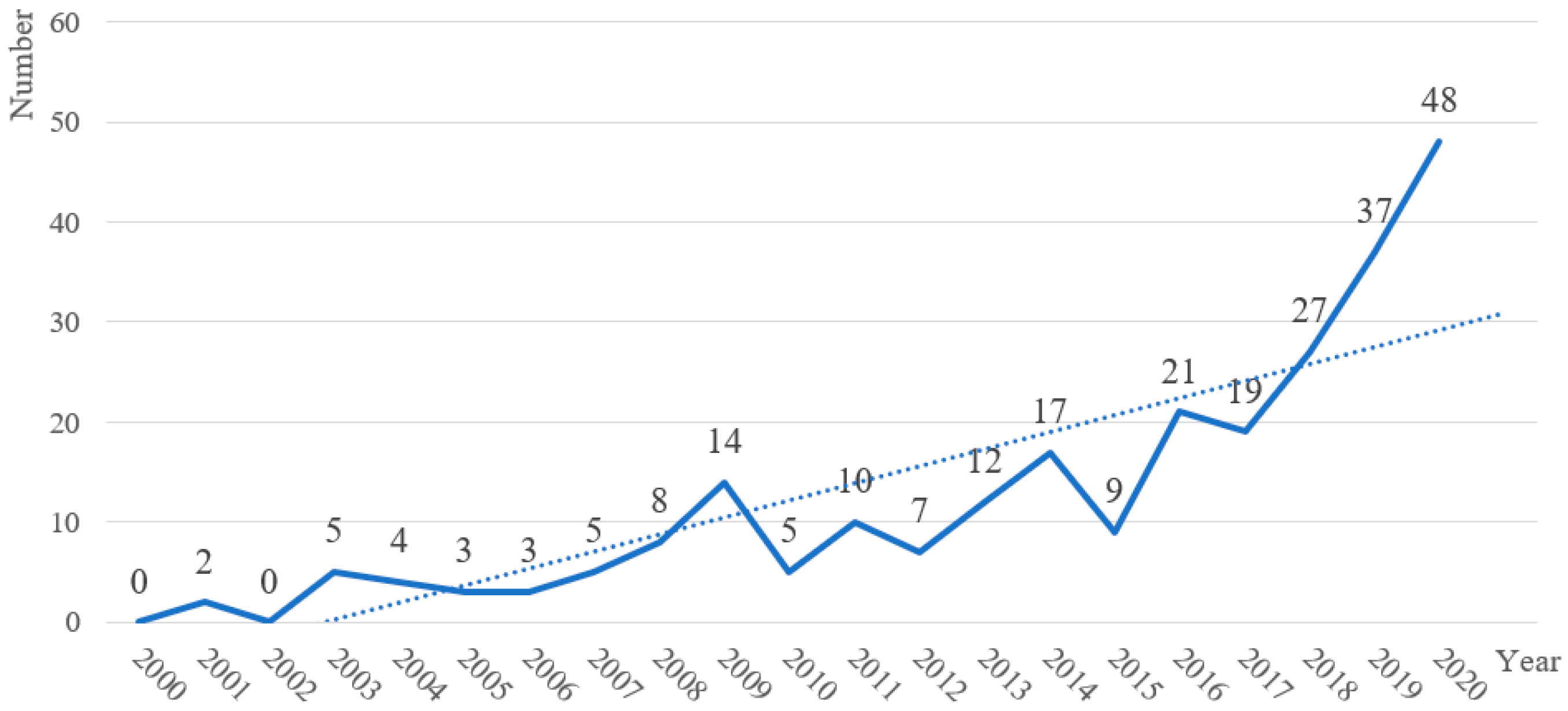
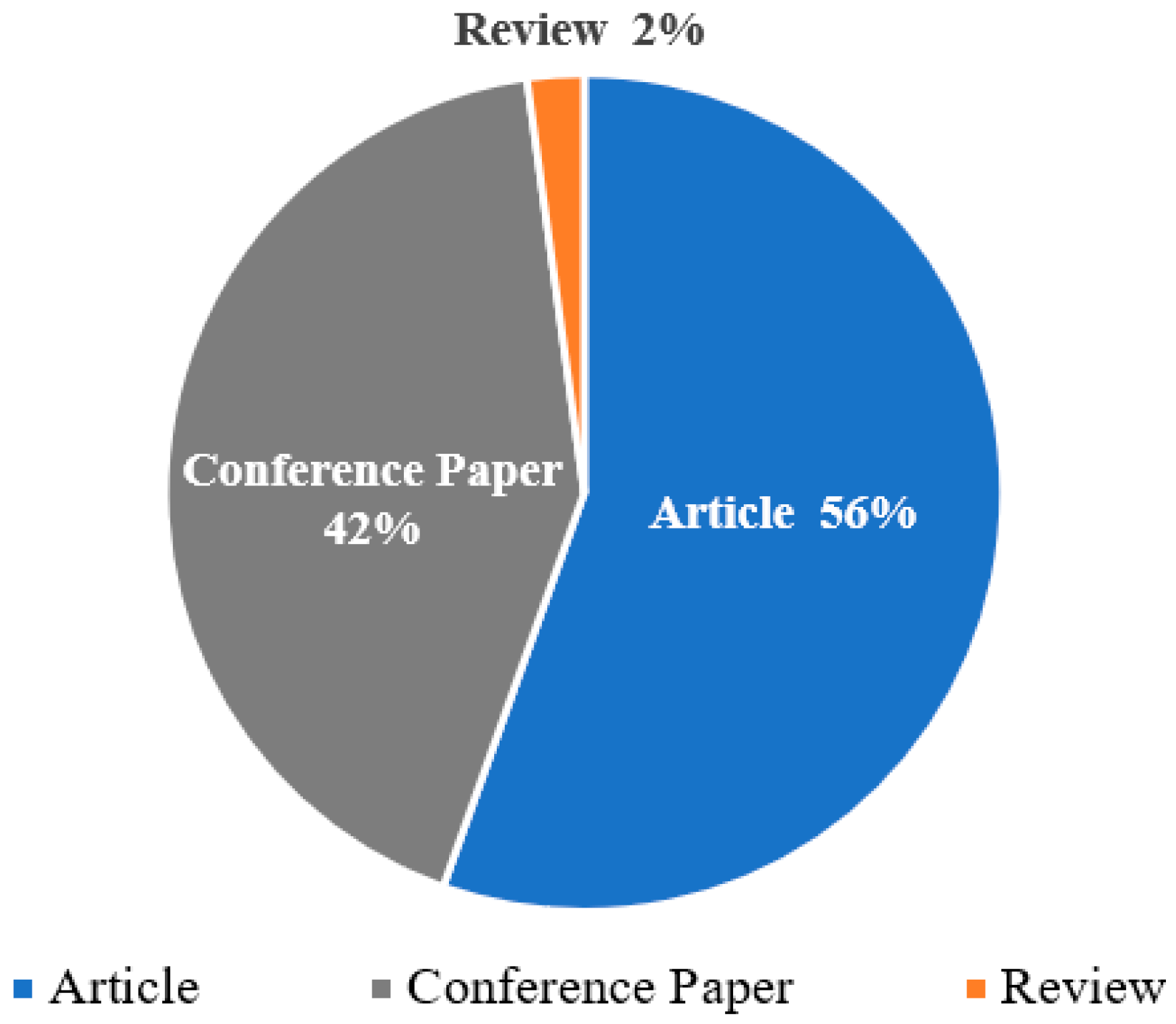

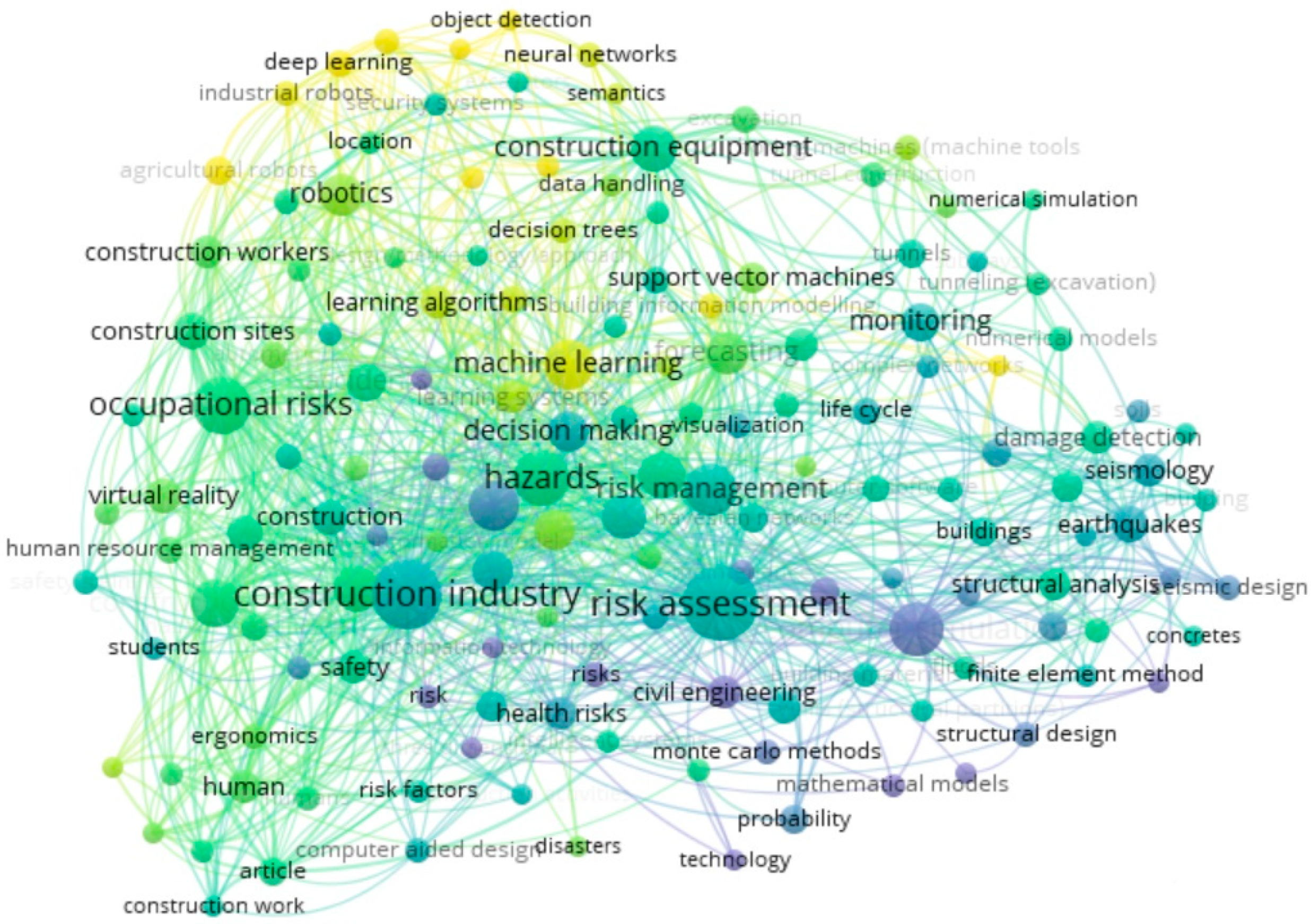
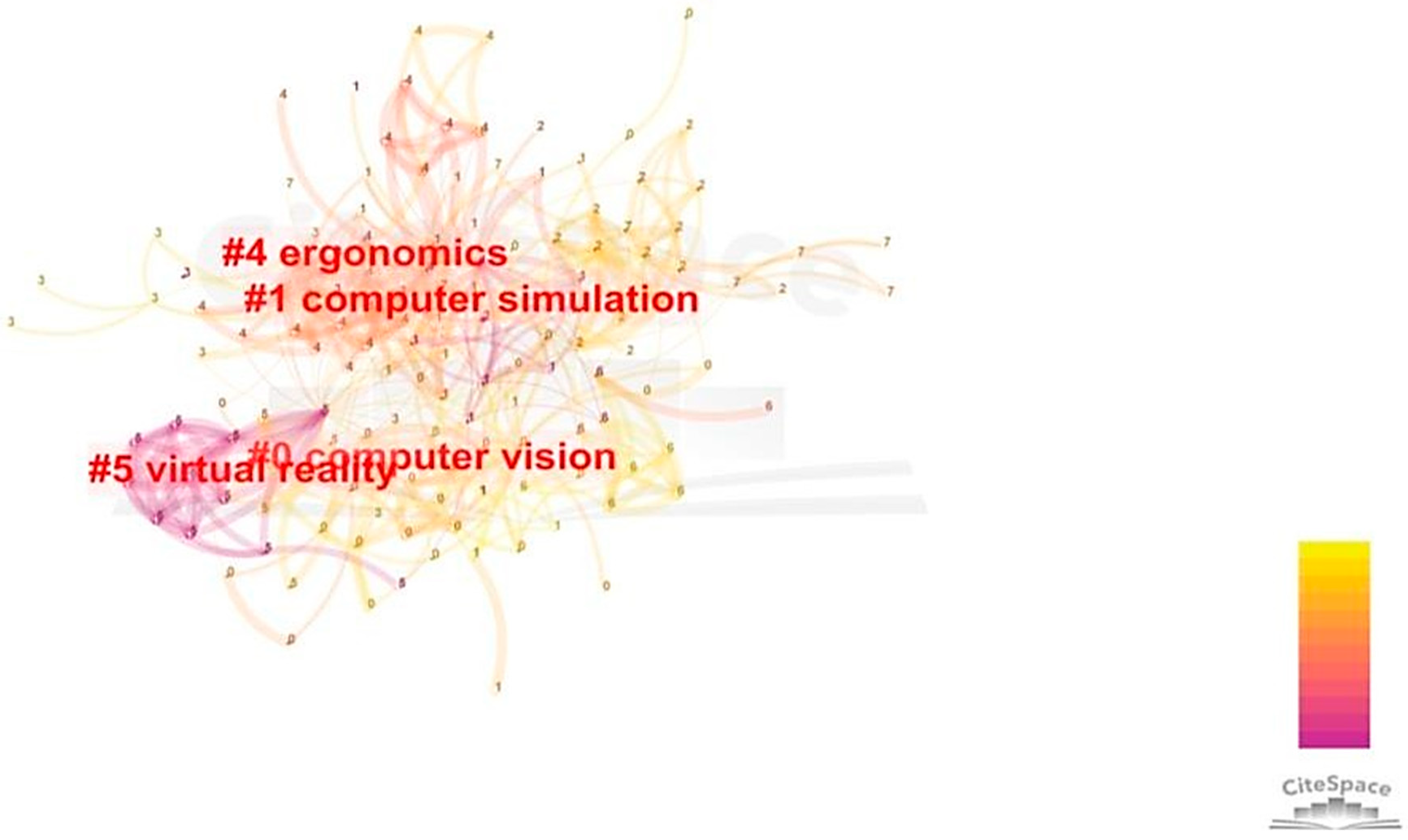

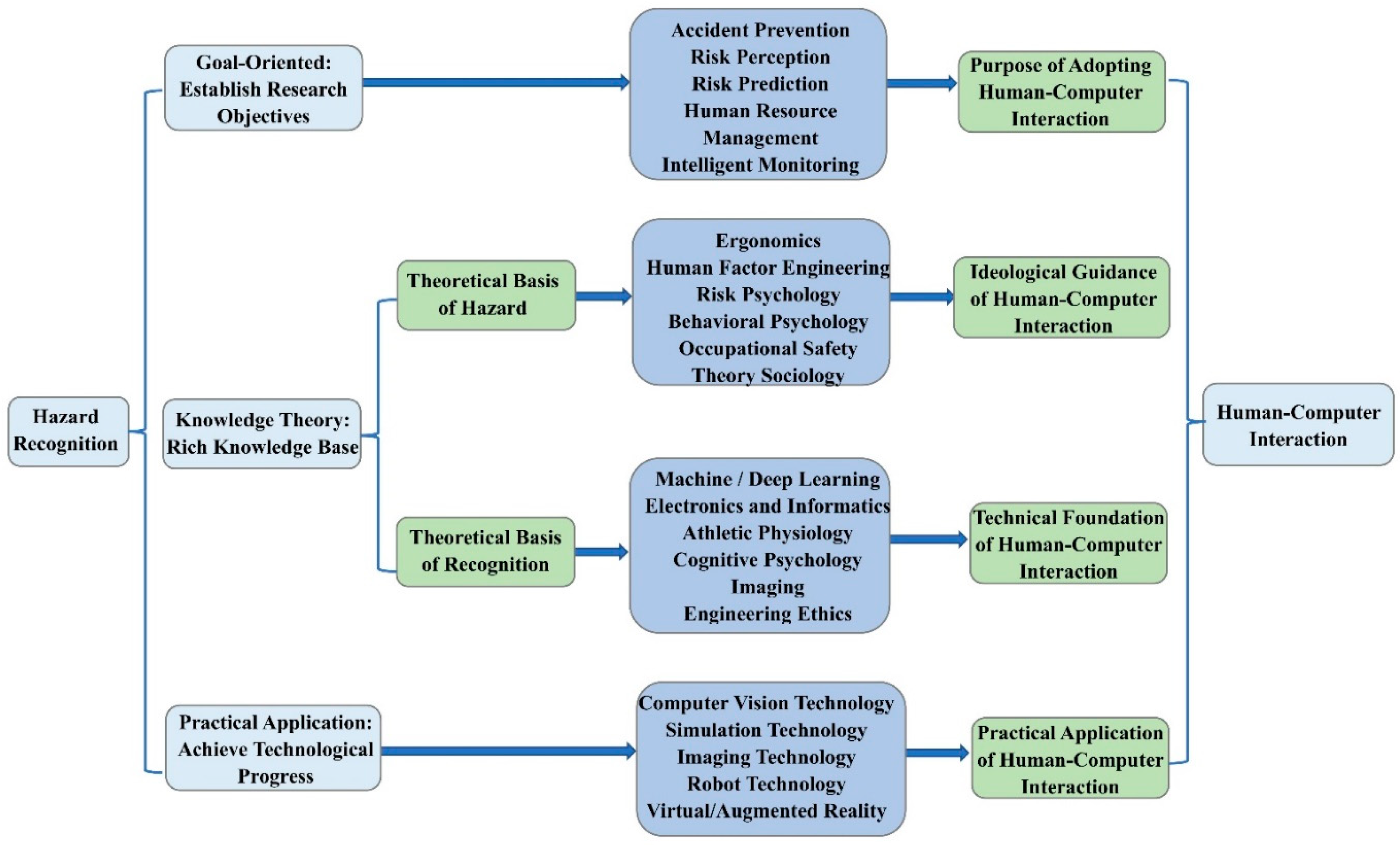
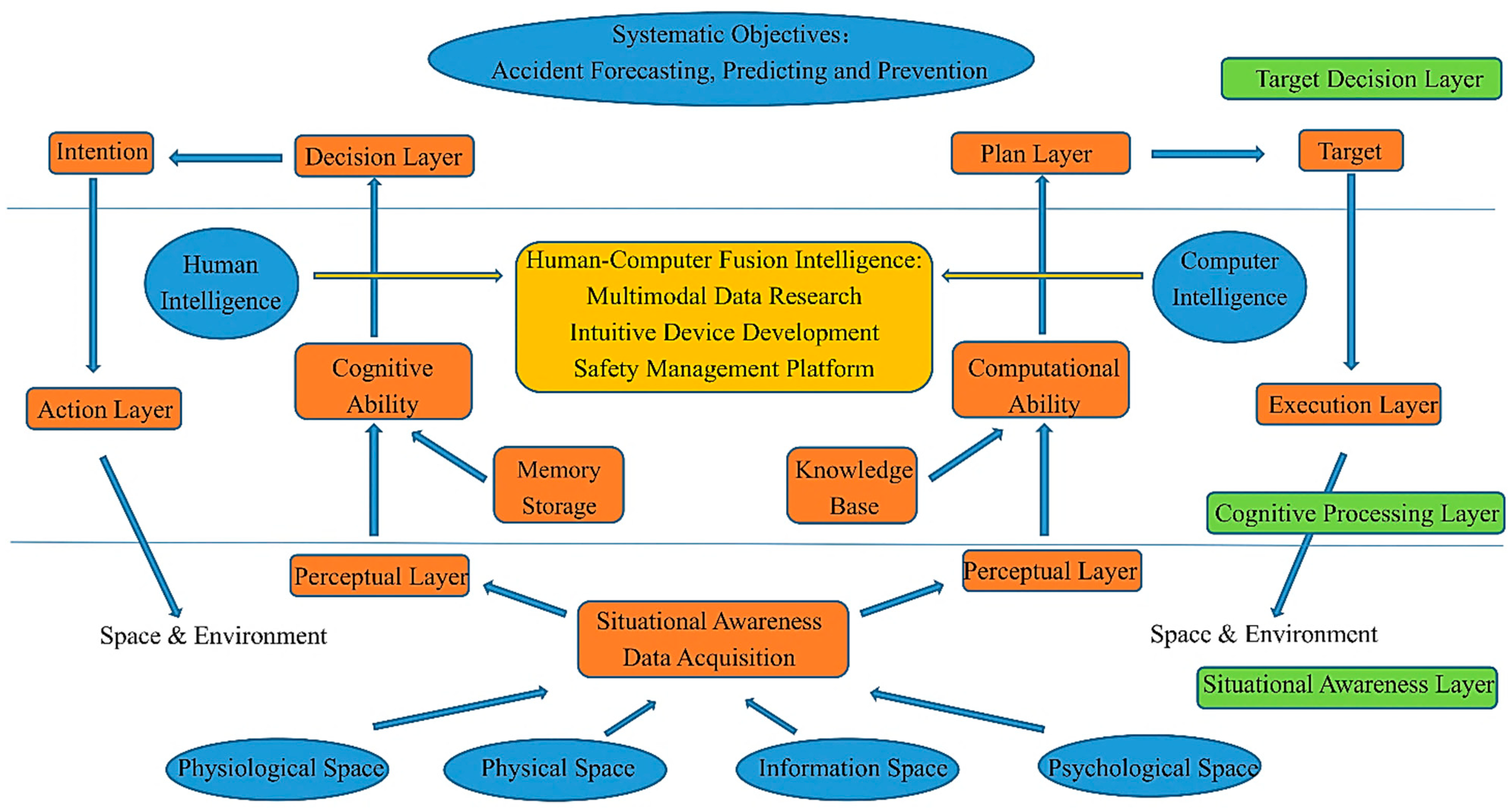
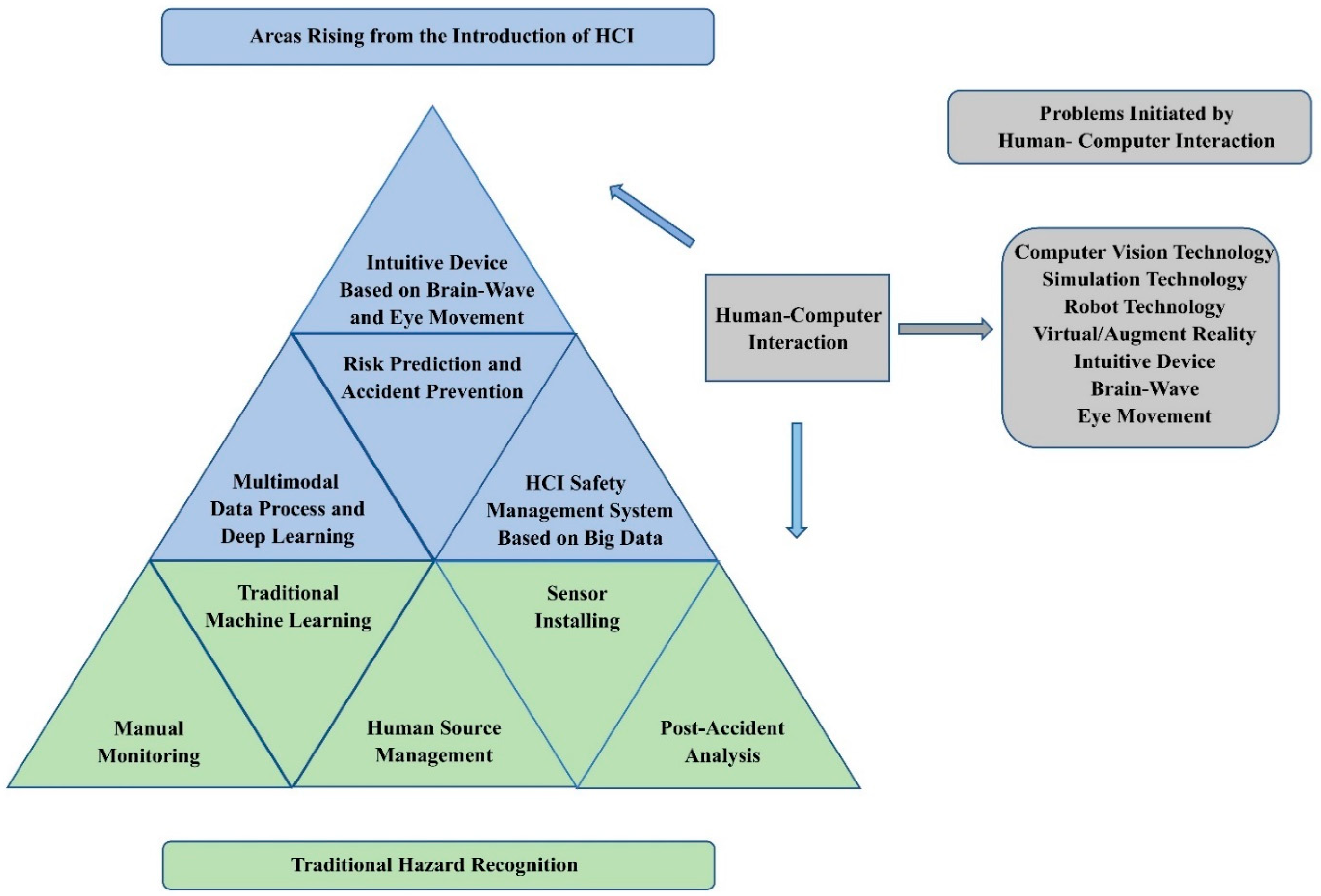
| Search Attributes | Values Used in the Search |
|---|---|
| Database | Scopus |
| Keywords | Construction hazard recognition; Human-computer interaction |
| Boolean operators | (TITLE-ABS-KEY(construct*) OR TITLE-ABS-KEY(build*) OR TITLE-ABS-KEY(erect)) AND (TITLE-ABS-KEY(hazard*) OR TITLE-ABS-KEY(hazard*) OR TITLE-ABS-KEY(peril) OR TITLE-ABS-KEY(risk*) OR TITLE-ABS-KEY(threat*)) AND (TITLE-ABS-KEY(recogni*) OR TITLE-ABS-KEY(identif*) OR TITLE-ABS-KEY(supervis*) OR TITLE-ABS-KEY(detect*) OR TITLE-ABS-KEY (inspect*) OR TITLE-ABS-KEY(realiz*) OR TITLE-ABS-KEY(cogni*) OR TITLE-ABS-KEY(notice*) OR TITLE-ABS- KEY(perceiv*) OR TITLE-ABS-KEY(verif*)) AND (TITLE-ABS-KEY(computer) OR TITLE-ABS-KEY(machine) OR TITLE-ABS-KEY(robot) OR TITLE-ABS-KEY(sensor)) AND (TITLE-ABS-KEY(collaborat*) OR TITLE-ABS-KEY(cooperat*) OR TITLE-ABS-KEY(interact*) OR TITLE-ABS-KEY(combin*)) AND PUBYEAR > 1999 |
| Keywords | Occurrence Times | Cluster Label |
|---|---|---|
| Accident Prevention | 24 | Computer Vision |
| Support Vector Machine | 20 | Computer Vision |
| Three-Dimensional Computer Graphics | 15 | Computer Vision |
| Risk Perception | 20 | Ergonomics |
| Risk Management | 13 | Ergonomics |
| Human Resource Management | 9 | Ergonomics |
| Machine Learning | 31 | Computer Simulation |
| Neural Networks | 28 | Computer Simulation |
| Monte Carlo Methods | 22 | Computer Simulation |
| Safety Training | 14 | Virtual Reality |
| Augmented Reality | 13 | Virtual Reality |
| Forecasting | 10 | Virtual Reality |
Publisher’s Note: MDPI stays neutral with regard to jurisdictional claims in published maps and institutional affiliations. |
© 2021 by the authors. Licensee MDPI, Basel, Switzerland. This article is an open access article distributed under the terms and conditions of the Creative Commons Attribution (CC BY) license (https://creativecommons.org/licenses/by/4.0/).
Share and Cite
Wang, J.; Cheng, R.; Liu, M.; Liao, P.-C. Research Trends of Human–Computer Interaction Studies in Construction Hazard Recognition: A Bibliometric Review. Sensors 2021, 21, 6172. https://doi.org/10.3390/s21186172
Wang J, Cheng R, Liu M, Liao P-C. Research Trends of Human–Computer Interaction Studies in Construction Hazard Recognition: A Bibliometric Review. Sensors. 2021; 21(18):6172. https://doi.org/10.3390/s21186172
Chicago/Turabian StyleWang, Jiaming, Rui Cheng, Mei Liu, and Pin-Chao Liao. 2021. "Research Trends of Human–Computer Interaction Studies in Construction Hazard Recognition: A Bibliometric Review" Sensors 21, no. 18: 6172. https://doi.org/10.3390/s21186172
APA StyleWang, J., Cheng, R., Liu, M., & Liao, P.-C. (2021). Research Trends of Human–Computer Interaction Studies in Construction Hazard Recognition: A Bibliometric Review. Sensors, 21(18), 6172. https://doi.org/10.3390/s21186172








